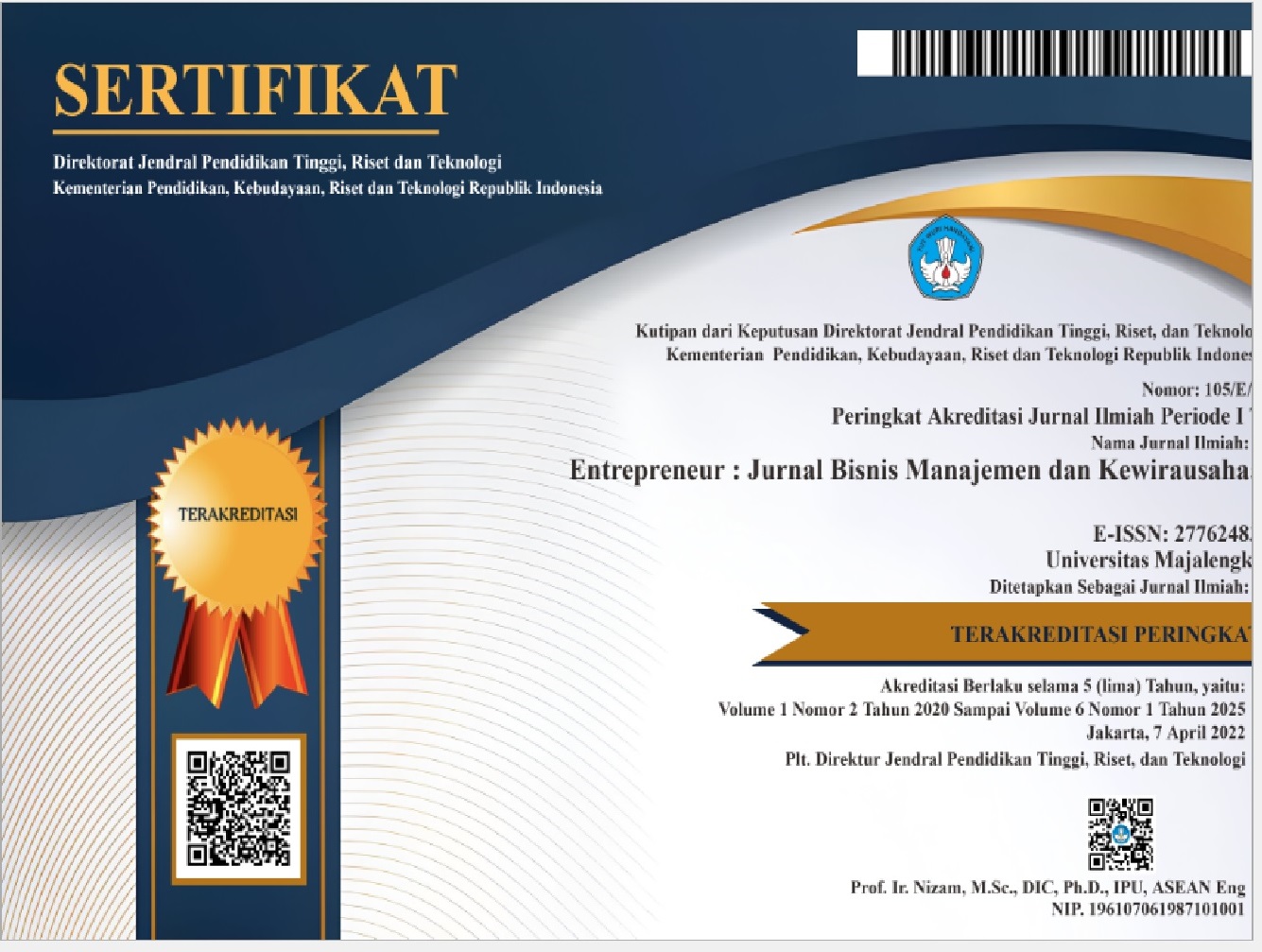Analisis Beban Kerja Menggunakan Metode Full Time Equivalent Pada Departemen Produksi PT XYZ
DOI:
https://doi.org/10.31949/entrepreneur.v5i1.8129Abstract
Product A at PT XYZ is one of the leading products that is in great demand by customers, which is characterized by an increase in sales in recent years. Therefore, to be able to ensure that customer demand can be met properly, the company must pay attention to human resources related to the production process. For this reason, the measurement of workload in the production department needs to be carried out with the aim of updating the actual data related to the workload borne by workers, so that the optimal number of workers can be known, besides that it can be used as a basis for determining policies when carrying out the recruitment process in the future. This research was conducted using the Full Time Equivalent (FTE) method, and the results obtained are that the production admin worker has a workload of 1.03 (labor required 1) and a fit workload, shift 1 production operators have a workload of 1 per three people (labor required 3) workload in a fit condition, shift 2 production operators have a workload of 0.82 per 2 operators (labor required 2) but the workload is still underload and finishing workers of 1.08 (labor required 1) workload in a fit condition.
Keywords:
Human Resources, Workload Analysis, Full Time Equivalent, RecruitmentDownloads
References
Ajitia N., M. G., & Prasetya, A. (2017). Efektivitas Manpower Planning Dengan Menggunakan Metode Analisis Beban Kerja (Work Load Analysis) Berdasarkan Pendekatan Full TIME Equivalent (Studi Pada Divisi Pengembangan Karir, Organisasi, Dan Kompetensi Di PT. Pupuk Kalimantan Timur Tbk. Bontang, Ka. Jurnal Administrasi Bisnis S1 Universitas Brawijaya, 42(1), 27–35.
Amsor, Y. R., Makaba, S., & Bouway, D. Y. (2022). Analisis Kebutuhan tenaga Perawat di Ruang Bedah Pria Rumah Sakit Umum Daerah Jayapura. Journals of Ners Community, 13(4), 438–448. http://journal.unigres.ac.id/index.php/JNC/article/view/2026
Arifin, M. F. I. N., & Purwaningsih, R. (2023). Penentuan Kebutuhan Tenaga Kerja Lapangan Dengan Metode Full Time Equivalent Pada Pekerjaan Pengambilan Sampah Rumah Ke Rumah Di Kabupaten Karangnyar. Industrial Engineering Online Journal; Vol 12, No 4 (2023): WISUDA PERIODE OKTOBER TAHUN 2023. https://ejournal3.undip.ac.id/index.php/ieoj/article/view/41402
Bakhtiar et al. (2021). Pengukuran Beban Kerja dengan Metode Full Time Equivalent dan Penentuan Jumlah Tenaga Kerja Efektif Menggunakan Workload Analysis. Journal of Industrial Engineering and Operation Management (JIEOM), 4(1).
Dilla et al. (2023). Pengukuran Beban Kerja Menggunakan Metode Full Time Equivalent (FTE) pada Department Information Technology & Development System PT. Bosowa Berlian Motor. PESHUM : Jurnal Pendidikan, Sosial Dan Humaniora, 2(6), 988–992. https://doi.org/10.56799/peshum.v2i6.2276
Handoko, M. S., & Sunardi. (2020). Kerja Dengan Metode Full Time Equivalent Di Badan Pengelolaan. 01(02), 129–139.
Hanjani, A. R., & Singgih, M. L. (2019). Workload analysis at biro human capital to increase productivity. IPTEK Journal of Proceedings Series, 5, 404–415.
Hasibuan et al. (2021). Perencanaan Dan Pengembangan SDM. Yayasan Kita Menulis. https://www.researchgate.net/publication/366951013_Perencanaan_dan_Pengembangan_SDM
Hibatullah, F. A., & Syam, N. S. (2022). Analisis Beban Kerja pada Karyawan Gudang Logistik Farmasi di RS PKU Muhammadiyah Kota Yogyakarta dengan Menggunakan Metode Full Time Equivalent. International Journal of Healthcare Research, 5(1).
Hidayati, R. A. (2022). Buku Ajar Perencanaan dan Pengembangan Sumber Daya Manusia. Deepublish Publisher.
Hudaningsih, N. (2019). Analisis Kebutuhan Karyawan Dengan Menggunakan Metode Full TIME Equivalent (Fte) Pada Departemen Produksi PT. Borsya Cipta Communica. Jurnal Tambora, 3(2), 98–106. https://doi.org/10.36761/jt.v3i2.278
Kurniawan, H. (2020). Analisis Beban Kerja Karyawan PT XYZ Indonesia pada Bagian Insulation Menggunakan Metode Full Time Equivalent. STRING (Satuan Tulisan Riset Dan Inovasi Teknologi), 5, 144. https://doi.org/10.30998/string.v5i2.7783
Purba, J. H. (2018). Perencanaan Strategi Sumberdaya Manusia dan Prestasi Kerja Karyawan. Jurnal Manajemen, 4(1), 43–51.
Purnaya, I. G. K. (2016). Manajemen Sumber Daya Manusia. ANDI.
Sudiro, A., & Putri, O. A. (2022). Manajemen Sumber Daya Manusia. BUMI AKSARA.
Sugiyono. (2016). Metode Penelitian Kuantitatif, Kualitatif, dan R&D. ALFABETA.
Sutrisno, E. (2020). Manajemen Sumber Daya Manusia. KENCANA.

Published
How to Cite
Issue
Section
License
Copyright (c) 2024 Ayu Wandini Aprilia, Maulidyah Amalina Rizqi

This work is licensed under a Creative Commons Attribution-ShareAlike 4.0 International License.
COPYRIGHT NOTICE
An author who publishes in the Entrepreneur: Jurnal Bisnis Manajemen dan Kewirausahaan agrees to the following terms:
1. Author retains the copyright and grants the journal the right of first publication of the work simultaneously licensed under the Creative Commons Attribution-ShareAlike 4.0 License that allows others to share the work with an acknowledgment of the work's authorship and initial publication in this journal
2. The author is able to enter into separate, additional contractual arrangements for the non-exclusive distribution of the journal's published version of the work (e.g., post it to an institutional repository or publish it in a book) with the acknowledgment of its initial publication in this journal.
3. The author is permitted and encouraged to post his/her work online (e.g., in institutional repositories or on their website) prior to and during the submission process, as it can lead to productive exchanges, as well as earlier and greater citation of the published work







